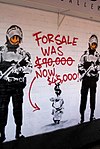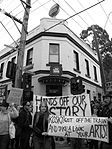Centre for Contemporary Photography
1986 establishments in AustraliaArt galleries established in 1986Art museums and galleries in MelbourneContemporary art galleries in AustraliaPhotography museums and galleries in Australia ... and 3 more
Use Australian English from June 2015Wikipedia external links cleanup from January 2021Wikipedia spam cleanup from January 2021

The Centre for Contemporary Photography (CCP), in Fitzroy, Melbourne, Victoria, is a venue for the exhibition of contemporary photo-based arts, providing a context for the enjoyment, education, understanding and appraisal of contemporary practice.
Excerpt from the Wikipedia article Centre for Contemporary Photography (License: CC BY-SA 3.0, Authors, Images).Centre for Contemporary Photography
George Street, Melbourne Fitzroy
Geographical coordinates (GPS) Address Phone number Website External links Nearby Places Show on map
Geographical coordinates (GPS)
| Latitude | Longitude |
|---|---|
| N -37.797222222222 ° | E 144.9825 ° |
Address
Centre for Contemporary Photography
George Street 404
3065 Melbourne, Fitzroy
Victoria, Australia
Open on Google Maps








